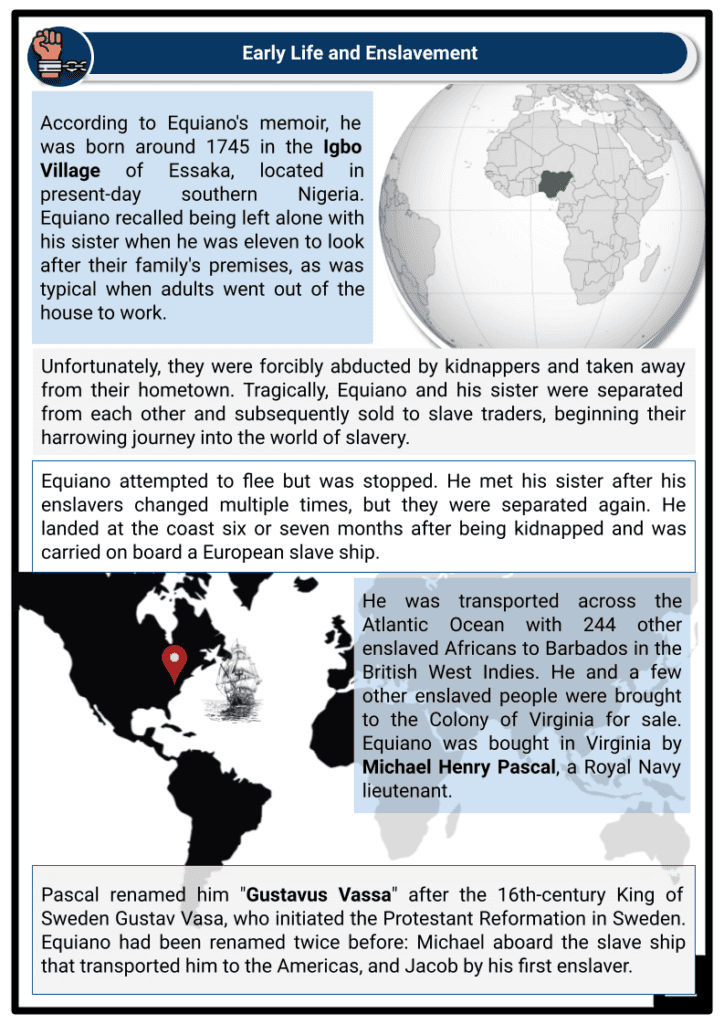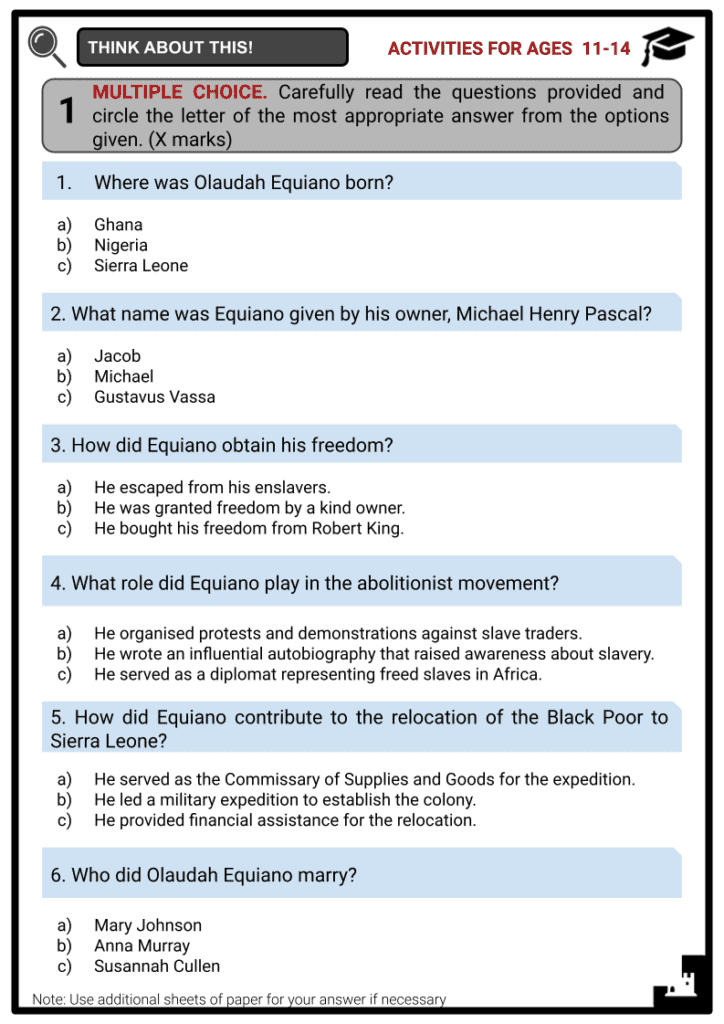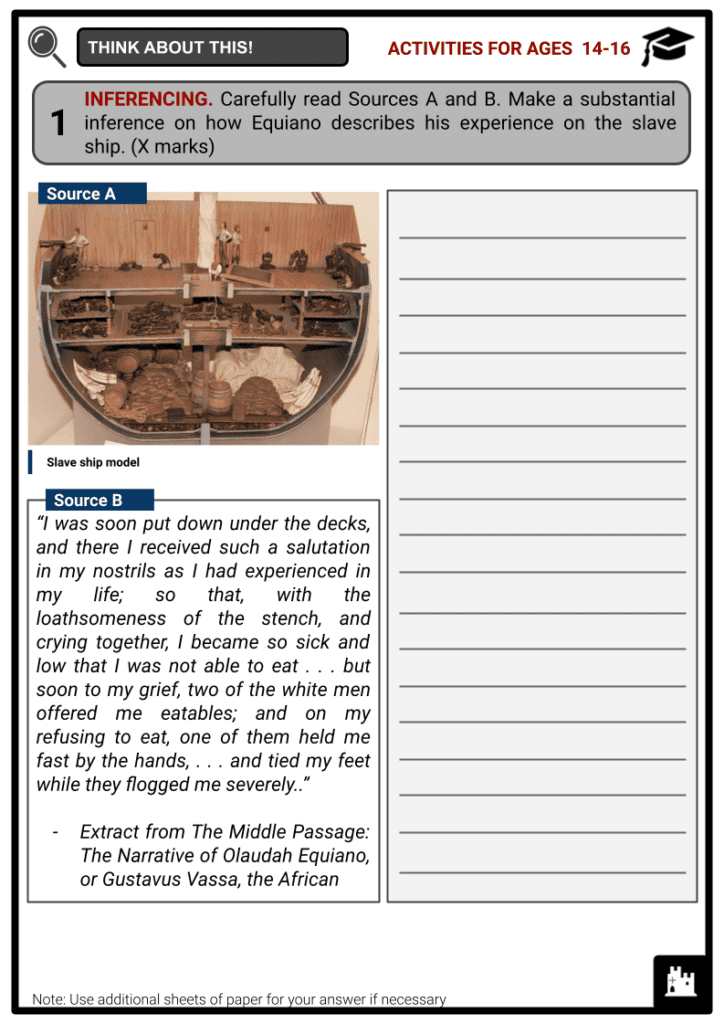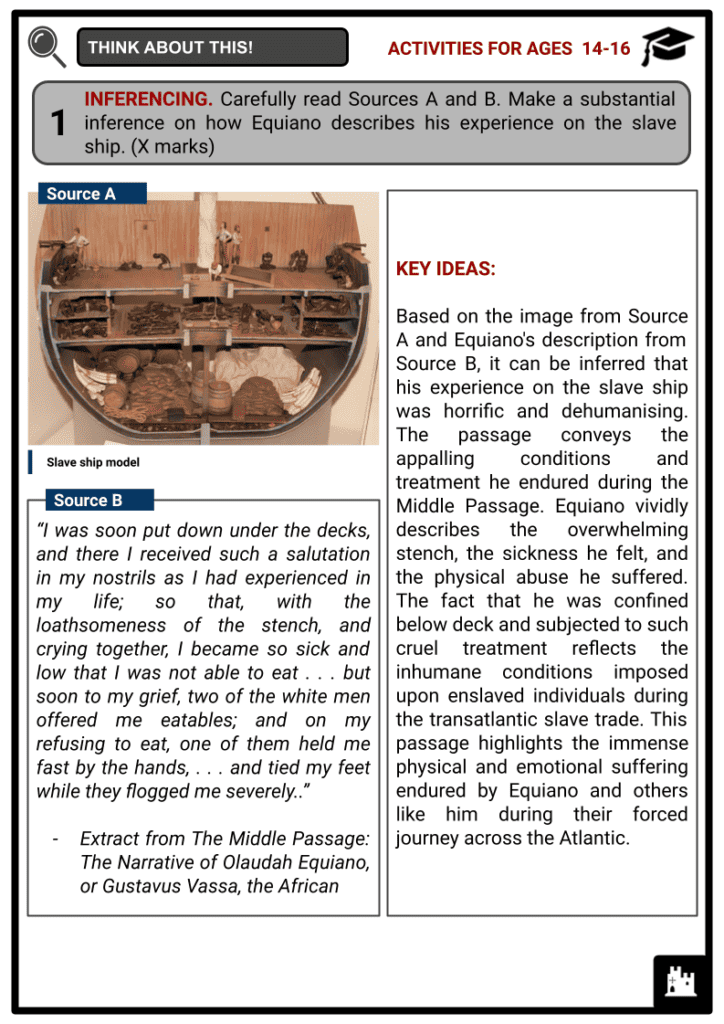Olaudah Equiano Worksheets
Do you want to save dozens of hours in time? Get your evenings and weekends back? Be able to teach about Olaudah Equiano to your students?
Our worksheet bundle includes a fact file and printable worksheets and student activities. Perfect for both the classroom and homeschooling!
Summary
- Early life and Enslavement
- Journey to Freedom and Advocacy
- Autobiography and Abolitionist Activism
- Later Years and Legacy
Key Facts And Information
Let’s find out more about Olaudah Equiano!
Olaudah Equiano was a prominent figure in the abolitionist movement and one of the most influential African writers of the 18th century. Born in Nigeria in 1745, Equiano was kidnapped as a child and sold into slavery. He endured the horrors of the transatlantic slave trade and was eventually transported to the British colonies. In 1789, he released his autobiography, where he became a fervent advocate for the abolition of slavery through his remarkable life journey. His book played a significant role in raising awareness about the atrocities of slavery and became a powerful instrument in the fight for human rights. 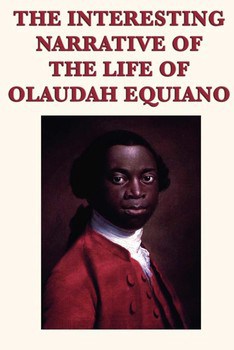
Early Life and Enslavement
- According to Equiano's memoir, he was born around 1745 in the Igbo Village of Essaka, located in present-day southern Nigeria. Equiano recalled being left alone with his sister when he was eleven to look after their family's premises, as was typical when adults went out of the house to work.
- Unfortunately, they were forcibly abducted by kidnappers and taken away from their hometown. Tragically, Equiano and his sister were separated from each other and subsequently sold to slave traders, beginning their harrowing journey into the world of slavery.
- Equiano attempted to flee but was stopped. He met his sister after his enslavers changed multiple times, but they were separated again. He landed at the coast six or seven months after being kidnapped and was carried on board a European slave ship.
- He was transported across the Atlantic Ocean with 244 other enslaved Africans to Barbados in the British West Indies. He and a few other enslaved people were brought to the Colony of Virginia for sale. Equiano was bought in Virginia by Michael Henry Pascal, a Royal Navy lieutenant.
- Pascal renamed him "Gustavus Vassa" after the 16th-century King of Sweden Gustav Vasa, who initiated the Protestant Reformation in Sweden. Equiano had been renamed twice before: Michael aboard the slave ship that transported him to the Americas, and Jacob by his first enslaver.
- Equiano expressed his disagreement and informed his new enslaver that he preferred the name Jacob. His reluctance, he claims, "gained me many a cuff," and he eventually agreed to the new name.
- He used the name Gustavus Vassa for the remainder of his life, including on all official papers. He solely used Equiano in his memoirs.
- Equiano's journey took a significant turn when Pascal brought him back to England as his companion and valet during the Seven Years' War with France from 1756 to 1763.
- Equiano, serving in the capacity of a valet, had the opportunity to witness significant events firsthand. He provides firsthand accounts of important historical events such as the Siege of Louisbourg in 1758, the Battle of Lagos in 1759, and the Capture of Belle Île in 1761.
- Equiano possessed seamanship skills and was expected to aid the ship's crew during battles, specifically in transporting gunpowder to the gun decks.
- Pascal held a favourable opinion of Equiano and decided to send him to his sister-in-law in Great Britain, where he could receive an education and learn how to read and write.
- Equiano converted to Christianity and was baptised on 9 February 1759 at St Margaret's, Westminster. He was described as "a Black, born in Carolina, 12 years old" in the parish registry.
- His godparents were cousins of his master Pascal, Mary Guerin and her brother Maynard Guerin.
- They were interested in him and helped him learn English. When Equiano's origins were called into doubt after his book was released, the Guerins testified about his lack of English when he first arrived in London.
- Equiano was sold by Pascal to Captain James Doran of the Charming Sally in December 1762 at Gravesend, and he was taken back to the Caribbean, to Montserrat in the Leeward Islands.
- He was sold there to Robert King, a Philadelphia-based American Quaker merchant who operated in the Caribbean.
Journey to Freedom and Advocacy
- Equiano was assigned to work on Robert King's shipping routes and in his businesses.
- In 1765, when Equiano was around 20 years old, King offered him that he could buy his freedom for 40 pounds (equivalent to £5,800 in 2021).
- King trained him to read and write more fluently, led him along the religious road, and allowed Equiano to engage in profitable trade for his own account as well as King's.
- Between Georgia and the Caribbean islands, Equiano sold fruits, glass tumblers, and other commodities.
- Equiano was able to buy his release from King in 1766. Equiano was persuaded to stay on as a business partner by the merchant.
- However, Equiano found it unsafe and restricting to stay a freedman in the British colonies. He was almost abducted back into slavery while loading a ship in Georgia.
- Equiano had moved to Britain by 1768. He continued to work at sea, occasionally as a deckhand located in England.
- In 1773, he embarked on an expedition to the North Pole aboard the Royal Navy ship HMS Racehorse.
- On that expedition, he collaborated with Dr. Charles Irving, who invented a method for distilling seawater and ultimately made a fortune from it.
- Two years later, Irving hired Equiano for a project on Central America's Mosquito Coast, where he would use his African heritage to help pick enslaved people and manage them as labourers on sugar-cane farms.
- For more than a decade, Irving and Equiano maintained a working connection and friendship, but the plantation business failed.
- Equiano sailed from the Mosquito Coast to Plymouth, England, on 7 January 1777.
- After settling in London, Equiano immersed himself in the abolitionist movement during the 1780s.

Josiah Wedgwood designed the 1787 Wedgwood anti-slavery medallion for the British anti-slavery campaign - While the Quakers had been at the forefront of the movement to end the slave trade, Equiano saw the need for a more inclusive approach.
- In response, the Society for Effecting the Abolition of the Slave Trade, also known as the Anti-Slavery Society, was established in 1787 as a non-denominational group, welcoming members from various religious backgrounds, including Anglicans, with the aim of exerting direct influence on parliament.
- At the time, only individuals willing to partake in the sacrament of the Lord's Supper according to the Church of England's customs were eligible to serve as Members of Parliament, as dictated by the Test Act.
- Equiano had been influenced by the evangelism of George Whitefield, which played a role in shaping his abolitionist convictions.
- Equiano's involvement in the abolitionist movement can be traced back to as early as 1783, when he began sharing crucial information about the slave trade with prominent abolitionists like Granville Sharp.
- During that year, Equiano played a significant role in informing Sharp about the horrific Zong massacre, a tragic event that was then being legally examined in London as part of insurance claims litigation.
- The Zong massacre gained widespread attention and became a cause célèbre for the abolitionist movement, and contributed significantly to its growth. The Zong massacre occurred on and after 29 November 1781, when the crew members of the British slave ship Zong carried out a mass killing of over 130 African enslaved people. This horrifying act was committed in an effort to recoup financial losses through insurance claims.
- On 21 October 1785, Equiano was part of a group of eight African delegates in America who expressed their gratitude to the Quakers during a meeting in Gracechurch Street, London.
- Their address was in response to Anthony Benezet's book, "A Caution to Great Britain and Her Colonies," which highlighted the plight of unlawfully formerly enslaved African people.
- Equiano found friendship and support among abolitionists, who not only encouraged him to write his life story, but also provided financial assistance for its publication.
- His efforts in delivering lectures and preparing the book were backed by philanthropic abolitionists and religious patrons, including Selina Hastings, the Countess of Huntingdon, among others.
Autobiography and Abolitionist Activism
- Equiano's book, published in 1789, garnered significant popularity and underwent nine editions during his lifetime. It stands as one of the earliest instances of a published work by an African writer that gained widespread readership in England.
- By 1792, it had become a bestseller and had been published in various countries, including Russia, Germany, Holland, and the United States.
- This influential work marked the inception of a substantial literary genre — the slavery narrative.
- However, Equiano's personal experience in enslavement differed from that of most enslaved individuals; he wasn't engaged in field labour but served his enslavers directly, went to sea, received education in reading and writing, and worked in trading.
- Equiano's first hand narrative of slavery, his remarkable journey of progress, and his unique experiences as an African immigrant captivated readers upon its release.

Image depicting Equiano's book - The book sparked a burgeoning anti-slavery movement that resonated in Great Britain, Europe, and the New World.
- Equiano's account astonished readers with its vivid imagery, detailed descriptions, and compelling literary style.
- Equiano described his village as well as the rules and customs of the Eboe people in his narrative. He mentioned communities he travelled through as a captive on his trip to the coast after being captured as a boy. His biography describes his passage on a slave ship as well as the horrors of slavery in the West Indian colonies of Virginia and Georgia.
- Equiano highlighted the limited rights and ongoing dangers faced by freed people of colour in the same places he had previously been enslaved.
- In his narrative, Equiano recounted his life in London, including his marriage to an English woman and their residence in Soham, Cambridgeshire, where they raised two daughters. During the 1780s, he emerged as a prominent abolitionist, delivering lectures across multiple cities to condemn the slave trade.
- Equiano documented his own and Granville Sharp's pivotal roles in the movement against the slave trade, shedding light on their efforts to bring attention to the infamous Zong massacre, which gained significant recognition in 1783.
- Equiano's book showcased the humanity of Africans and exposed the horrors of slavery, earning praise as a significant work of English literature by an African author. His book sold well, granting him financial independence and allowing him to travel across England, Scotland, and Ireland to promote it.
- Equiano also worked towards improving economic, social, and educational conditions in Africa, particularly in Sierra Leone, a British colony established for formerly enslaved Africans in West Africa.
- In 1783, after the United States gained independence, Equiano actively engaged in assisting the Black Poor community in London.
- This group primarily consisted of enslaved African-Americans who had been released by the British during and after the American Revolution.
- It also included freed, formerly enslaved, people from the Caribbean and individuals who had been brought to England by their enslavers and later emancipated due to the recognition that slavery had no legal basis in British common law.
- In November 1786, Equiano was appointed as the "Commissary of Supplies and Goods for the Black Poor Travelling to Sierra Leone."
- This appointment was part of an expedition to relocate London's Black Poor to Freetown, a newly established British colony in present-day Sierra Leone, located on the west coast of Africa.
- The group from London was joined by over 1,200 African Loyalists who had decided to leave Nova Scotia.
- They received assistance from John Clarkson, the younger brother of abolitionist Thomas Clarkson.
- In addition to them, enslaved people rescued from illegal slave-trading vessels after Britain banned the slave trade also settled in Freetown during its early years.
- However, Equiano's time in the settlement was cut short when he was dismissed after raising concerns about financial mismanagement. He subsequently returned to London.
- Equiano emerged as a prominent figure in London, representing the African community and serving as a spokesperson.
- He played a leading role in the Sons of Africa, a small abolitionist group composed of free Africans in London.
- His views and perspectives on various issues were regularly published in newspapers like the Public Advertiser and the Morning Chronicle.
- Equiano actively participated in the London Corresponding Society, a radical working-class organisation advocating for democratic reform.
- During his travels across the British Isles in 1791-1792 to promote his autobiography, he established connections between the Society and the United Irishmen, potentially marking the Society's first interactions with the latter group.
- His visit to Belfast in May 1791 was hailed by local abolitionists, who had previously successfully opposed plans to use the port for slave trade purposes.
Later Years and Legacy
- Equiano married Susannah Cullen, a local woman, on 7 April 1792, in St Andrew's Church, Soham, Cambridgeshire.
- Equiano made sure to include his marriage in every edition of his autobiography, starting from 1792.
- After their marriage, the pair settled in the area and had two daughters named Anna Maria (1793–1797) and Joanna (1795–1857). Both daughters were baptised at Soham Church.
- Sadly, Susannah, Equiano's wife, passed away in February 1796 at the age of 34.
- Equiano himself passed away just a year later on 31 March 1797. Shortly after, their elder daughter, Anna Maria, also passed away at the age of four.
- This left their younger child, Joanna Vassa, as the sole inheritor of Equiano's estate when she reached the age of 21.
- At the time of Equiano's death, the estate was valued at £950, which is equivalent to £77,000 in 2021.
- Anna Maria is remembered and honoured with a plaque at St Andrew's Church in Chesterton, Cambridge. As for Joanna, she married the Reverend Henry Bromley, a Congregationalist minister, in 1821.
Legacy
- Equiano drafted his will on 28 May 1796, while residing at Plaisterers' Hall in Aldermanbury, London.
- He later moved to John Street near Whitefield's Tabernacle in Tottenham Court Road.
- Upon his passing on 31 March 1797, he was living in Paddington Street, Westminster.
- The news of Equiano's death was covered not only in British but also American newspapers.
- In his will, Equiano specified that if his daughters were to pass away before turning 21, half of his wealth would be left to the Sierra Leone Company for a school in Sierra Leone, and the other half to the London Missionary Society.
- The formation of the Equiano Society took place in London in November 1996, aiming to raise awareness and commemorate the life and accomplishments of Olaudah Equiano.
- Equiano is recognised and commemorated by the Church of England, included in its Calendar of Saints with a Lesser Festival on 30 July, alongside Thomas Clarkson and William Wilberforce, notable figures who worked to abolish the slave trade and slavery.
- In 2007, during the bicentenary celebration of the abolition of the slave trade in Britain, Equiano's life and achievements were incorporated into the National Curriculum, along with William Wilberforce.
- A statue of Equiano, created by students from Edmund Waller School, was erected in Telegraph Hill Lower Park, New Cross, London, in 2008. Additionally, the head of Equiano is featured in Martin Bond's sculpture "Wall of the Ancestors" in Deptford, London, created in 1997.
- Author Ann Cameron adapted Equiano's autobiography for children, preserving much of his original text. The book, titled "The Kidnapped Prince: The Life of Olaudah Equiano," was published in 1995 in the United States by Random House, with an introduction by historian Henry Louis Gates Jr.
- On 16 October 2017, Google Doodle commemorated Equiano's 272nd birthday, honouring his life and contributions.
Image Sources
- https://www.simonandschuster.com/books/The-Interesting-Narrative-of-the-Life-of-Olaudah-Equiano/Olaudah-Equiano/9781625584717
- https://en.wikipedia.org/wiki/Abolitionism_in_the_United_Kingdom#/media/File:Official_medallion_of_the_British_Anti-Slavery_Society_(1795).jpg
- https://commons.wikimedia.org/wiki/File:The_Interesting_Narrative_of_the_Life_of_Olaudah_Equiano,_or_Gustavus_Vassa,_the_African_%282920684386%29.jpg


